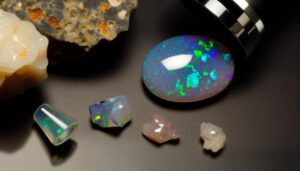Top 5 Distinctive Features of Fire Agate vs Fire Opal
Fire agate and fire opal both originate uniquely; fire agate forms in volcanic environments with layered silica crystallization, while fire opal forms in sedimentary rocks from silica sphere deposition. Fire agate, with a Mohs hardness of 6.5-7 and specific gravity of 2.60, is denser and harder than fire opal, which has a hardness of 5.5-6.5 and specific gravity of 1.98-2.25.
Fire agate showcases iridescent hues due to the Schiller effect, whereas fire opal exhibits vibrant, translucent colors. Each stone has distinct care requirements, historical significance, and metaphysical benefits.
There's much more to explore regarding their unique properties and uses.
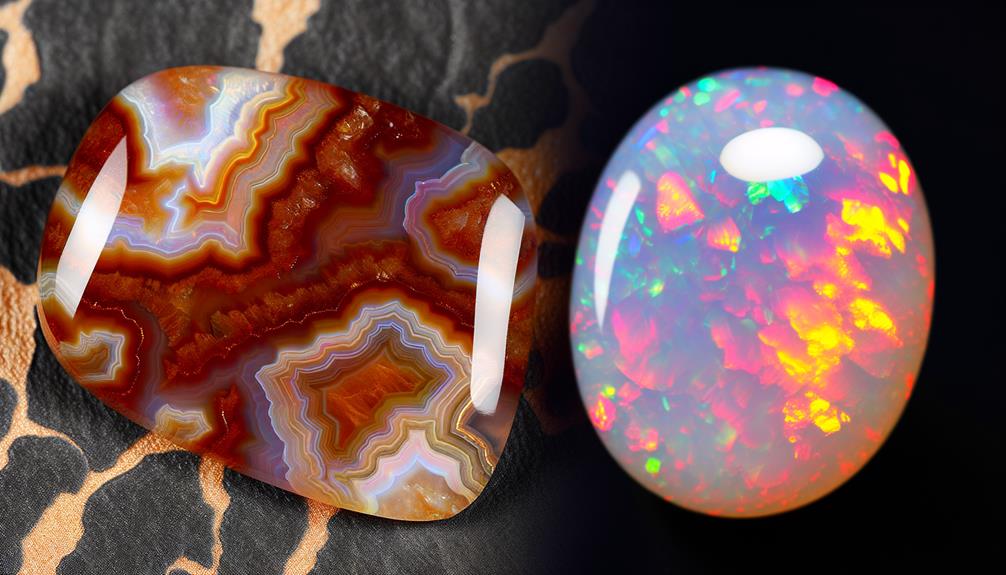
Key Takeaways
- Fire agate is harder (Mohs 6.5-7) than fire opal (Mohs 5.5-6.5), making it more resistant to scratches.
- Fire agate displays iridescent, banded patterns with a Schiller effect, while fire opal shows uniform, vibrant colors.
- Fire agate forms in volcanic environments, whereas fire opal forms in sedimentary rocks.
- Fire agate is associated with grounding and the root chakra, while fire opal enhances creativity linked to the sacral chakra.
- Fire agate's intricate patterns and limited availability make it more valuable; fire opal's vibrant colors maintain steady demand.
Origins and Formation
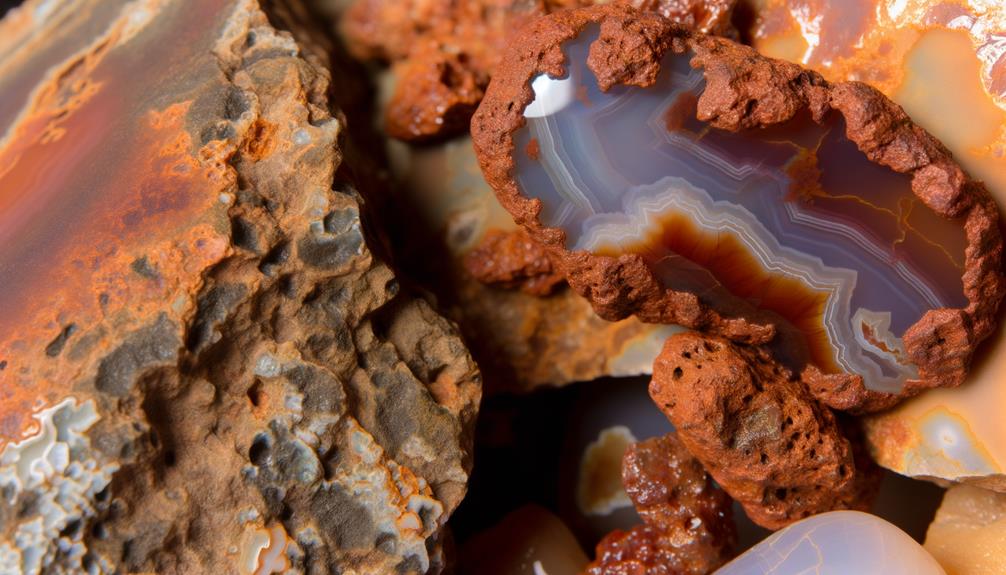
Fire agate and fire opal originate from distinct geological processes. Fire agate forms in volcanic environments where silica-rich water deposits layers in cavities. This gem develops from hydrothermal activity, with temperature fluctuations causing silica to crystallize in concentric layers, creating the unique iridescent effect seen in fire agate.
On the other hand, fire opal forms in sedimentary rocks through the gradual deposition of silica spheres in a gel-like matrix. The formation of fire opal involves low-temperature sedimentary processes. Silica-rich water seeps into cracks and voids in sedimentary rock, slowly depositing silica spheres. These spheres, arranged in a regular pattern, diffract light, producing the play-of-color characteristic of fire opal.
Understanding these processes helps explain the unique appearances of fire agate and fire opal.
Physical Properties
When examining the physical properties of agate and opal, you'll notice distinct differences in their hardness, refractive indices, and specific gravity. Fire agate has a Mohs hardness of 6.5-7, making it relatively more durable than fire opal, which ranges from 5.5 to 6.5.
Their refractive indices also differ, with fire agate around 1.54-1.55 and fire opal between 1.37-1.52. Specific gravity is another key parameter; fire agate generally has a specific gravity of about 2.60, while fire opal ranges from 1.98 to 2.25.
Hardness:
- Fire agate (6.5-7)
- Fire opal (5.5-6.5)
Refractive Index:
- Fire agate (1.54-1.55)
- Fire opal (1.37-1.52)
Specific Gravity:
- Fire agate (2.60)
- Fire opal (1.98-2.25)
Durability:
- Fire agate is more durable than fire opal
Color and Appearance
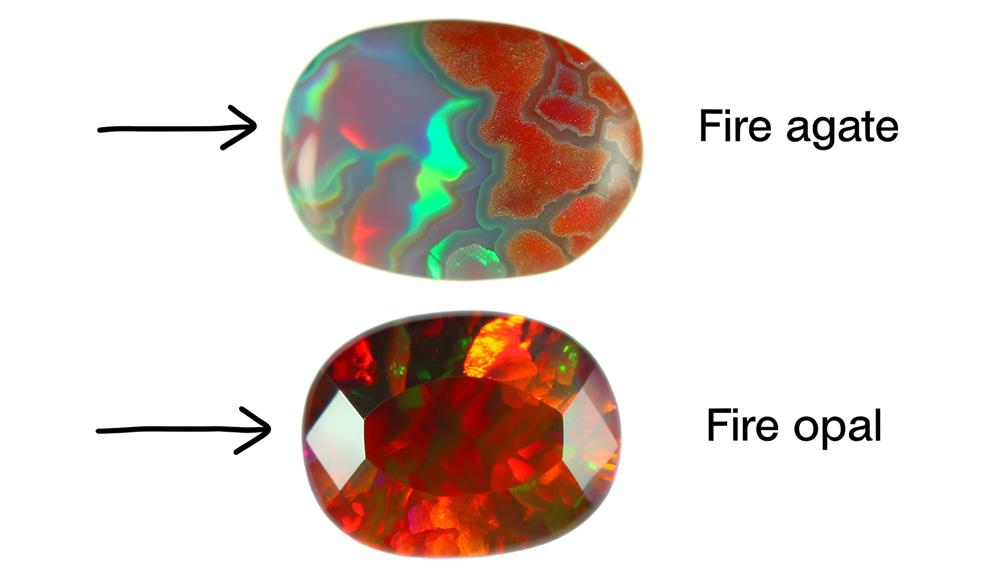
Examining the color and appearance of these gemstones reveals striking contrasts, with fire agate displaying iridescent hues and intricate banding patterns, while fire opal exhibits a range of vibrant, often translucent colors.
Fire agate's iridescence, known as 'Schiller,' results from light interference within its microcrystalline layers. You'll notice how these layers create a spectrum of colors, from deep reds to vivid greens, depending on the viewing angle.
In contrast, fire opal doesn't exhibit banding but instead showcases uniform body colors like orange, red, and yellow, often with a translucent to transparent quality. This translucency allows light to pass through, enhancing its fiery appearance.
Both gemstones captivate the eye, but their unique optical properties set them apart.
Historical Significance
When examining the historical significance of fire agate and fire opal, you'll find that both gemstones have rich cultural histories. Fire agate was revered in ancient civilizations for its purported protective qualities, while fire opal was highly valued in Aztec and Mayan cultures for its vibrant colors and symbolic meanings.
Additionally, these gems played pivotal roles in historical trade routes, influencing economic and cultural exchanges between regions.
Ancient Cultural Uses
Throughout history, both fire agate and fire opal have held significant roles in various cultures, often being revered for their perceived mystical properties and healing abilities.
Ancient civilizations utilized these gemstones in several ways:
- Amulets and Talismans: Fire agate was often used as a protective amulet, believed to shield the wearer from negative energies.
- Medicinal Practices: Fire opal was ground into powders and used in traditional medicine for its supposed ability to cure ailments.
- Ritualistic Ceremonies: Both stones featured prominently in rituals, symbolizing elements like fire and earth.
- Artistic Embellishments: Cultures embedded these gems into sculptures and jewelry, showcasing their vibrant colors.
These uses reflect the deep cultural significance and multifaceted applications of fire agate and fire opal across different societies.
Symbolism in Mythology
In mythological narratives, fire agate and fire opal are often symbolized as embodiments of elemental forces. Fire agate represents protection and grounding, while fire opal embodies passion and transformation.
You'll find that fire agate's historical significance is rooted in its association with stability and defense against negative influences. It's believed to channel the earth's energy, fostering emotional equilibrium.
Conversely, fire opal's vivid hues are linked to the element of fire, symbolizing energy, creativity, and dynamic change. This gemstone is thought to stimulate the heart and mind, encouraging personal growth and renewal.
Historical Trade Routes
Understanding the mythological symbolism of fire agate and fire opal enriches our appreciation of their historical significance, particularly when examining how these gemstones traveled along ancient trade routes, becoming prized commodities in various cultures. Fire agate and fire opal moved through:
- Silk Road: Facilitated exchange between East Asia and Europe.
- Trans-Saharan routes: Linked Sub-Saharan Africa with Mediterranean economies.
- Maritime Spice Routes: Enabled trade across the Indian Ocean.
- Mesoamerican networks: Integrated regions within ancient American civilizations.
These networks allowed the diffusion of fire agate and fire opal, embedding them in diverse cultural artifacts and symbolisms. This historical movement underscores their enduring value and multifaceted roles in global trade dynamics. Understanding their journey offers insight into ancient economic systems and cultural exchanges.
Symbolism and Meaning
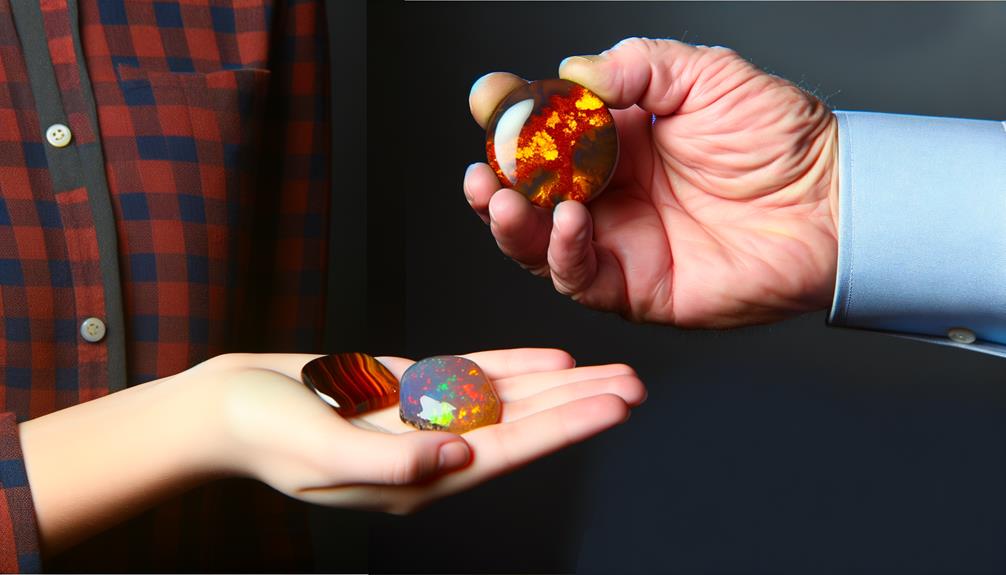
Fire agate and fire opal, both revered for their vibrant play of colors, carry distinct symbolic meanings rooted in their unique geological formations and cultural histories.
Fire agate, formed in volcanic environments, symbolizes protection and grounding. Its intricate banding patterns are often associated with inner strength and spiritual fortitude.
In contrast, fire opal, created through sedimentary processes, embodies passion and creativity. Its fiery hues and transparency are linked to emotional expressiveness and spontaneity.
Geologically, fire agate's chalcedony structure imparts stability, while fire opal's hydrated silica composition suggests fluidity and adaptability.
Understanding these stones' symbolism offers you deeper insights into their cultural significance and personal resonance.
Common Uses
You'll find that both fire agate and fire opal are extensively used in the creation of intricate jewelry and adornments due to their unique visual properties.
Additionally, practitioners in the field of metaphysics often use these stones for their purported healing properties and energetic benefits.
Jewelry and Adornments
When selecting gemstones for jewelry, how do fire agate and fire opal compare regarding aesthetic appeal, durability, and popularity?
Fire agate features vivid iridescence due to its layered chalcedony structure, making it extremely eye-catching. In contrast, fire opal's vibrant play-of-color comes from silica spheres, offering a more delicate aesthetic.
Fire agate is harder (6.5-7 Mohs), ensuring greater durability for everyday wear, whereas fire opal is softer (5.5-6.5 Mohs), requiring more care.
Both stones enjoy popularity, but their uses vary:
- Fire Agate: Ideal for rings, bracelets, and statement pieces.
- Fire Opal: Often used in earrings, pendants, and less-exposed jewelry.
- Fire Agate: Known for its earthy tones and resilience.
- Fire Opal: Valued for its vibrant, fiery hues.
Understanding these differences helps you choose the right gem for your needs.
Healing and Metaphysical Properties
Both fire agate and fire opal are believed to possess unique healing and metaphysical properties that can enhance emotional well-being and spiritual growth. Fire agate, associated with the root chakra, is thought to provide grounding energy, promote courage, and dispel fear, making it a popular choice for stress relief.
You might use it in meditation to amplify protective vibrations.
Fire opal, linked with the sacral chakra, is reputed to boost creativity, passion, and emotional stability. It's often utilized to stimulate sexual energy and bolster self-confidence.
You can incorporate fire opal into crystal healing practices to balance emotional states and inspire positive transformation.
Both stones serve distinct yet complementary roles in metaphysical applications, aiding in holistic emotional and spiritual support.
Care and Maintenance
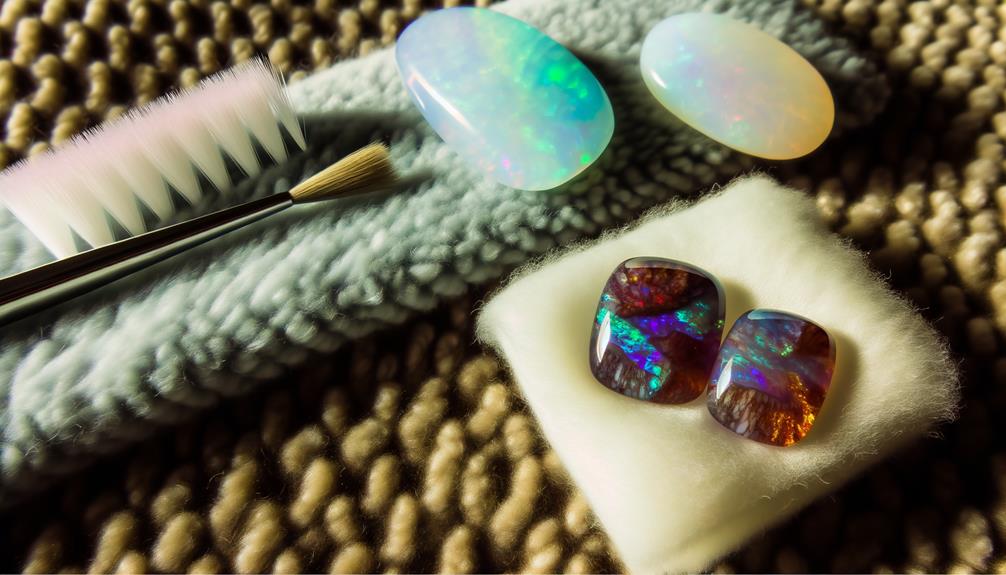
To guarantee the longevity and brilliance of fire agate and fire opal, understanding their distinct care requirements is essential. Fire agate, with its Mohs hardness of 6.5-7, is relatively durable but still requires caution to avoid scratches. Conversely, fire opal, with a hardness of 5.5-6.5, demands more delicate handling due to its higher susceptibility to damage. Proper maintenance involves avoiding harsh chemicals and extreme temperatures.
- Clean with lukewarm water and mild soap.
- Use a soft cloth for drying and polishing.
- Store separately to prevent physical abrasion.
- Regularly inspect for signs of wear or damage.
Value and Market Trends
Fire agate and fire opal exhibit distinct value trajectories in the gem market, influenced by factors such as rarity, color intensity, and overall quality.
Fire agate, with its intricate patterns and iridescence, often commands higher prices due to its unique geological formation and limited availability. The value escalates with vibrant color play and well-defined banding.
Conversely, fire opal is prized for its transparent to translucent body and vivid hues, ranging from red to orange. Market trends indicate a steady demand for high-quality fire opals, especially those with uniform color distribution and minimal inclusions.
When evaluating either gem, consider factors such as cut, carat weight, and origin, as these greatly impact market value and investment potential.
Conclusion
In comparing fire agate and fire opal, you've navigated a rich tapestry of geological wonders. Both gems, with their distinct origins, physical properties, and vibrant hues, present unique appeals. They've carved historical significance and symbolism into the annals of human culture.
Their applications, care needs, and market values differ, yet both shine brightly in their own right. Like two sides of a coin, they offer dual paths to beauty and fascination.






